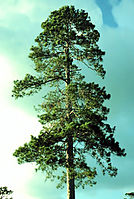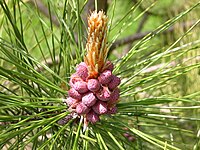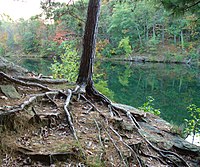Pinus resinosa
| Red pine | |
|---|---|

| |
| Trees at Sherburne NWR, Minnesota
| |
| Scientific classification | |
| Kingdom: | Plantae |
| Clade: | Tracheophytes |
| Clade: | Gymnospermae |
| Division: | Pinophyta |
| Class: | Pinopsida |
| Order: | Pinales |
| Family: | Pinaceae |
| Genus: | Pinus |
| Subgenus: | P. subg. Pinus
|
| Section: | P. sect. Pinus
|
| Subsection: | P. subsect. Pinus
|
| Species: | P. resinosa
|
| Binomial name | |
| Pinus resinosa | |

| |
Pinus resinosa, known as red pine[2][3] (also Norway pine in Minnesota),[4] is a pine native to North America.[5]
Description
Red pine is a coniferous evergreen tree characterized by tall, straight growth.[6] It usually ranges from 20–35 metres (66–115 feet) in height and 1 m (3 ft 3 in) in trunk diameter, exceptionally reaching 43.77 m (143+1⁄2 ft) tall.[7] The crown is conical, becoming a narrow rounded dome with age. The bark is thick and gray-brown at the base of the tree, but thin, flaky and bright orange-red in the upper crown; the tree's name derives from this distinctive character. Some red color may be seen in the fissures of the bark. The species is self pruning; there tend not to be dead branches on the trees, and older trees may have very long lengths of branchless trunk below the canopy.[5]
The
The pine grows well in sandy soils and on soils which are too poor for white pine.[5]
Phylogeny
Red pine is notable for its very constant morphology and low genetic variation throughout its range, suggesting it has been through a near extinction in its recent evolutionary history.[8][9] A genetic study of nuclear microsatellite polymorphisms among populations distributed throughout its natural range found that red pine populations from Newfoundland are genetically distinct from most mainland populations, consistent with dispersal from different glacial refugia in this highly self-pollinating species.[10]
-
An old tree in Itasca State Park, Minnesota
-
Pollen cones in spring
-
 Cone (scale in cm)
Cone (scale in cm) -
Red pine boughs, showing yellowing and abscission of older foliage in the autumn.
-
Treeerodedaway around the roots of this young red pine tree.
Distribution and habitat
It occurs from Newfoundland west to Manitoba, and south to Pennsylvania, with several smaller, disjunct populations occurring in the Appalachian Mountains in Virginia and West Virginia, as well as a few small pockets in extreme northern New Jersey and northern Illinois.[1][11]
It can be found in a variety of habitats.[5]
Ecology
It is intolerant of shade, but does well in windy sites; it grows best in well-drained soil. It is a long-lived tree, reaching a maximum age of about 500 years.[12]
Uses
The
The wood is light, hard, and very close grained. It is not durable in contact with soil without chemical treatment. It is used in construction for piling, masts, spars, boxes, and crates.[5]
In culture
The red pine is Minnesota's
References
- ^ . Retrieved 11 November 2021.
- ^ ISBN 978-1-4027-3875-3.
- ^ "Red Pine". dnr.state.mn.us. Minnesota Department of Natural Resources.
- ^ a b Hoyt, Richard (21 September 2017). "Red Pine Tree Facts". gardenguides.com. Retrieved 24 February 2022.
- ^ a b c d e f Grimm, William Carey (1966). The Book of Trees. Harrisburg, Pennsylvania: The Stockpole Company. p. 43.
- ^ a b Kral, Robert (1993). "Pinus resinosa". In Flora of North America Editorial Committee (ed.). Flora of North America North of Mexico (FNA). Vol. 2. New York and Oxford: Oxford University Press – via eFloras.org, Missouri Botanical Garden, St. Louis, MO & Harvard University Herbaria, Cambridge, MA.
- ^ Earle, Christopher J., ed. (2018). "Pinus resinosa". The Gymnosperm Database. Retrieved 5 February 2012.
- doi:10.1139/x77-043.
- doi:10.1139/x86-198.
- PMID 21652464.
- ^ Hilty, John (2020). "Pinus resinosa". Illinois Wildflowers. Retrieved May 1, 2017.
- ^ "Eastern OLDLIST: A database of maximum tree ages for Eastern North America". Columbia Climate School, Columbia University. Retrieved February 24, 2022 – via ldeo.columbia.edu.
- ^ "State Tree- Norway Pine". sos.state.mn.us. Minnesota Secretary of State.
- ^ Wright, Jacob J. (September 21, 2017). "What is a Norway Pine Tree?". gardenguides.com. Archived from the original on June 27, 2019. Retrieved February 24, 2022.
External links
- Interactive Distribution Map of Red Pine at plantmaps.com






